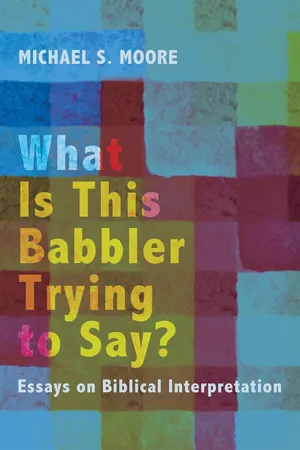
eBook - ePub
What Is This Babbler Trying to Say?
Essays on Biblical Interpretation
Moore
This is a test
- 368 pagine
- English
- ePUB (disponibile sull'app)
- Disponibile su iOS e Android
eBook - ePub
What Is This Babbler Trying to Say?
Essays on Biblical Interpretation
Moore
Dettagli del libro
Anteprima del libro
Indice dei contenuti
Citazioni
Informazioni sul libro
This book is a collection of revised-and-updated essays about the Hebrew Bible written by a North American scholar over a period of several decades. Subdivided into three parts--Torah, Prophecy/Apocalyptic, and Wisdom--these seventeen essays attempt to model for younger scholars and students what the discipline of biblical interpretation can look like, attending carefully to literary, historical, canonical, and comparative intertextual methods of investigation.
Domande frequenti
Come faccio ad annullare l'abbonamento?
È semplicissimo: basta accedere alla sezione Account nelle Impostazioni e cliccare su "Annulla abbonamento". Dopo la cancellazione, l'abbonamento rimarrà attivo per il periodo rimanente già pagato. Per maggiori informazioni, clicca qui
È possibile scaricare libri? Se sì, come?
Al momento è possibile scaricare tramite l'app tutti i nostri libri ePub mobile-friendly. Anche la maggior parte dei nostri PDF è scaricabile e stiamo lavorando per rendere disponibile quanto prima il download di tutti gli altri file. Per maggiori informazioni, clicca qui
Che differenza c'è tra i piani?
Entrambi i piani ti danno accesso illimitato alla libreria e a tutte le funzionalità di Perlego. Le uniche differenze sono il prezzo e il periodo di abbonamento: con il piano annuale risparmierai circa il 30% rispetto a 12 rate con quello mensile.
Cos'è Perlego?
Perlego è un servizio di abbonamento a testi accademici, che ti permette di accedere a un'intera libreria online a un prezzo inferiore rispetto a quello che pagheresti per acquistare un singolo libro al mese. Con oltre 1 milione di testi suddivisi in più di 1.000 categorie, troverai sicuramente ciò che fa per te! Per maggiori informazioni, clicca qui.
Perlego supporta la sintesi vocale?
Cerca l'icona Sintesi vocale nel prossimo libro che leggerai per verificare se è possibile riprodurre l'audio. Questo strumento permette di leggere il testo a voce alta, evidenziandolo man mano che la lettura procede. Puoi aumentare o diminuire la velocità della sintesi vocale, oppure sospendere la riproduzione. Per maggiori informazioni, clicca qui.
What Is This Babbler Trying to Say? è disponibile online in formato PDF/ePub?
Sì, puoi accedere a What Is This Babbler Trying to Say? di Moore in formato PDF e/o ePub, così come ad altri libri molto apprezzati nelle sezioni relative a Theology & Religion e Religion. Scopri oltre 1 milione di libri disponibili nel nostro catalogo.
Informazioni
Argomento
Theology & ReligionCategoria
ReligionPart 1: Torah
1
ANOTHER LOOK AT BALAAM*
Balaam ben Beor is a multidimensional figure, whether we examine his activity in the Hebrew Bible, in Second Temple Judaism, or on the plaster inscription from Tell Deir `Allā.1 Within the Balaam cycle in Tanak (Num 22–24) the text depicts him as Yahweh’s “obedient servant.”2 Yet within this cycle he also behaves as a bungling buffoon in a satirical “burlesque,”3 a blind “seer” unable to “see” Yahweh’s angel standing directly in his path. Micah of Moresheth preserves a memory of him acting as Moab’s antagonist (Mic 6:3–5), but most Tanak sources depict him as Israel’s quintessential antagonist.4
This polarized response to Balaam hardens in several Second Temple texts. Ps.-Philo, for example, continues to portray him as God’s faithful “servant” (Lat servum tuum)5 while an anonymous rabbinic commentator calls him “a prophet greater than Moses.”6 Contradicting these portrayals, however, the Fragment Targums,7 Talmud,8 and Greek New Testament9 all portray him as “Balaam the Wicked.”10 Recognizing the danger posed by such lopsided polarization, Josephus cautiously suggests that readers go back to Tanak and examine it carefully before making up their minds about Balaam.11
The Deir `Allā texts give us more information. Here Balaam appears as a “seer of the gods” (ḥzn ’lhn) on the first line of Combination 1,12 an envoy allegedly chosen by a divine council to convey a doomsday oracle to a local populace. Combination 2, however, though more fragmentary, depicts him in categories more congruent with the occultic activity alluded to in Num 31:16.13 Whatever the interpretive possibilities,14 the DA discovery removes all doubt about the existence of a non-Hebrew Balaam tradition in Iron Age Transjordan among a people evidently non-Yahwistic and probably non-Israelite.
Yet in spite of this new evidence several studies of this ancient Near Eastern specialist continue to constrict his multidimensionality within bipolar parameters first proposed by nineteenth-century literary critics to explain, prior to the great archaeological discoveries of the twentieth century, the character and development of Torah. Within this framework Balaam is either a “blesser” or a “curser,” but these are the only options.15 The vestigial “2-source” hypothesis underlying this polarized framework has been and continues to be contested. Some angrily rail at it;16 others try to work within its bipolar parameters (often without presuming the existence of independent literary “documents”);17 and still others ignore it.18 Few attempt to engage seriously the sociohistorical context out of which the Balaam traditions originate.19
The question raised here is therefore simple. Is Balaam only a “curser”/”blesser,” or is the nineteenth-century bipolar approach to the Balaam traditions inadequate and outdated? Without denying that Tanak editors largely succeed in corralling the Balaam traditions within enclosures structured by the “blessing-curse” polarity,20 perpetuation of this nineteenth-century approach practically guarantees that the multidimensional roles enacted by this specialist will remain hidden from view. Better to switch methodological gears and re-examine the Balaam traditions from a perspective informed by selected anthropological studies of religion,21 especially the adaptable variables generated by co...